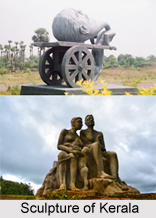 Iconographic representations of most of the major figures in the Hindu pantheon are available in Kerala. The stone and wood carvings of Kerala show the high level of sculptural excellence attained by the artists. The earliest specimen of stone carvings in Kerala can be found in the Edakkal Caves in Sultan`s Battery in Wayanad district. They depict human and animal figures and objects of human use and symbols. Specimens of some of the early sculptural art of Kerala can be seen in the rock-cut temples of the post-Sangam period. While the sculptures in the southern group show traces of Pandyan influence, those in the northern group are reminiscent of Pallavan influence.
Iconographic representations of most of the major figures in the Hindu pantheon are available in Kerala. The stone and wood carvings of Kerala show the high level of sculptural excellence attained by the artists. The earliest specimen of stone carvings in Kerala can be found in the Edakkal Caves in Sultan`s Battery in Wayanad district. They depict human and animal figures and objects of human use and symbols. Specimens of some of the early sculptural art of Kerala can be seen in the rock-cut temples of the post-Sangam period. While the sculptures in the southern group show traces of Pandyan influence, those in the northern group are reminiscent of Pallavan influence.
The stone images of the Lord Buddha sittings in the yoga asana posture discovered from such places as Karumadi, Mavelikkara, Bharanikkavu, Maruthurkulangara and Pallikkal are also among the finest examples of early stone sculptures of Kerala. They are believed to show traces of the influence of the Buddhist art of Sri Lanka. The Jain images of Lord Mahavira and other Jain Tirthankaras obtained from different places also form an invaluable part of the sculptural heritage of Kerala.
The temples of Kerala contain exquisite sculptures, particularly in stone, which exhibit influences of different dynasties such as Pandya, Chola, and Vijayanagar etc. The figures of deities and animals and of dance scenes on the walls and balustrades of temples are typical of the temple sculpture of Kerala. The Parasurama shrine at Thiruvalla has interesting panels depicting animals like elephants and lions. The Shiva temple at Kandiyur has exquisite stone sculptures depicting Puranic legends and myths. In the Haripad Subramanya temple, there is an imposing stone figure of Lord Hanuman. The sculpture of Sree Padmanabhaswami temple, Thiruvananthapuram, Varkala Janardhana Temple and Vaikom Shiva temple are the products of the influence of the later Vijayanagar and Nayak styles. These temples are considered as treasure houses of the best 18th century stone sculptures.
The wood carvings in Kerala temples show the art at its best similar to that of stone sculptures. The most common of the wood carvings are seen on the Namaskara Mandapas. They depict figures of Navgrahas on the ceiling and Puranic figures on the rafters and beams. The Kuthambalams are also noted for their fabulous wood carvings, as for example, those in the temples of Subramaniam at Kidangur and Haripad. Wooden walls with beautiful carvings are also seen in several temples. In addition, there are wooden bracket figures, sculptural columns, etc. The Mahadeva temple, Katinamkulam, the Sri Mahadeva temple, Kaviyur, the Narasimha temple, Chathankulangara, the Sri Vallabha temple, Tiruvalla, the Sri Rama temple, Triprayar and the Krishna temple, Trichambaram are some of the temples of Kerala noted for exquisite wood sculptures.



















